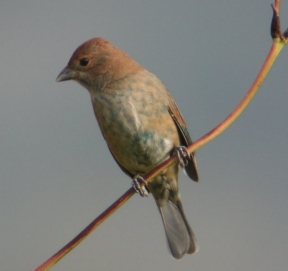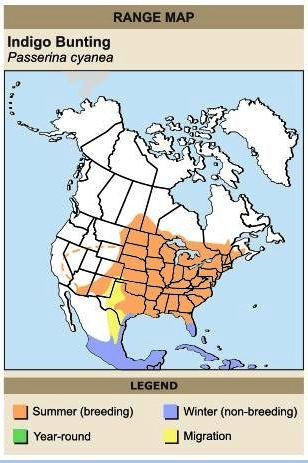
Small finch with
brilliant, almost iridescent, blue plumage. Crown is darker blue with
a purple tint. Wings and tail are black with blue edges.
Feeds on insects, larvae, grains, seeds, berries. Short flights low
over vegetation, alternates rapid wing beats with wings pulled to sides.
|
INDIGO
BUNTING
Passerina cyanea
PASSERIFORMES
Cardinals and Grosbeaks (Cardinalidae)
Range
and Habitat
Breeds from southeastern Saskatchewan east to New Brunswick, and south
to central Arizona, central Texas, the Gulf coast, and northern Florida.
Spends winters in southern Florida and in the tropics. Preferred habitats
include brushy slopes, abandoned farmlands, old pastures and fields
grown to scrub, woodland clearings, and forest edges adjacent to fields.
SOUND: "sweet-sweet, sweeter-sweeter, here-here"

Indigo Buntings are actually black; the diffraction
of light through their feathers makes them look blue. This explains
why males can appear many shades from turquoise to black.
They are more common now than when the pilgrims first landed. This is
due to an increase in their favorite habitat of woodland edges, such
as power line clearings and along roads.
They migrate at night, using the pattern of stars nearest the
North Star to guide them. In captivity, these birds
will become disoriented if they can’t see the stars in
April/May and September/October.
A group of buntings are collectively known as a "decoration",
"mural", and "sacrifice" of buntings.
The Indigo Bunting is rated as Least Concern at this time. The range
of the Indigo Bunting is approximately 6 million kilometers. The population
of this bird species is about
28 million individual birds. The prior rating for the Indigo Bunting
was Lower Risk. That rating was downgraded to
Least Concern in 2004. The Indigo Bunting is native to
numerous countries throughout the Caribbean as well as
Central America and North America. It is also a visitor to countries
in Europe as well. There are no threats facing the population of the
Indigo Bunting at this time.
|





